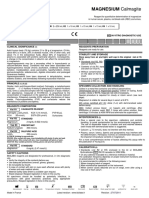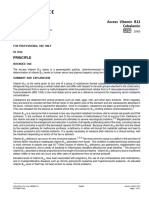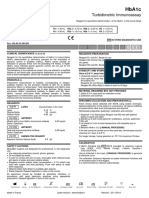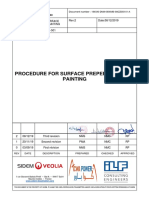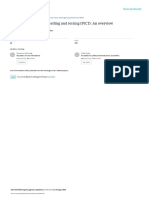Professional Documents
Culture Documents
Kit Insert Magnesium (Calmagite)
Kit Insert Magnesium (Calmagite)
Uploaded by
rai cita0 ratings0% found this document useful (0 votes)
28 views2 pagesCopyright
© © All Rights Reserved
Available Formats
PDF, TXT or read online from Scribd
Share this document
Did you find this document useful?
Is this content inappropriate?
Report this DocumentCopyright:
© All Rights Reserved
Available Formats
Download as PDF, TXT or read online from Scribd
Download as pdf or txt
0 ratings0% found this document useful (0 votes)
28 views2 pagesKit Insert Magnesium (Calmagite)
Kit Insert Magnesium (Calmagite)
Uploaded by
rai citaCopyright:
© All Rights Reserved
Available Formats
Download as PDF, TXT or read online from Scribd
Download as pdf or txt
You are on page 1of 2
BIOLABO
www.biolabo.fr MAGNESIUM CALMAGITE
MANUFACTURER:
BIOLABO SAS, High Stability-High Linearity
Les Hautes Rives
02160, Maizy, France
Reagent for quantitative determination of magnesium
in human serum, plasma, urines.
REF 98212 R1 2 x 200 mL R2 1 x 10 mL
TECHNICAL SUPPORT AND ORDERS
Tél : (33) 03 23 25 15 50 | IVD IN VITRO DIAGNOSTIC USE
Fax: (33) 03 23 256 256
CLINICAL SIGNIFICANCE (1) REAGENTS PREPARATION
Adult human body (70 Kg) contains 21 to 28 g of magnesium. Of this, Reagents are ready for use.
about 60% is in bone, 20% in skeletal muscle, 19% in other cells, and
about 1% in the extracellular fluids. About 30% of magnesium in STABILITY AND STORAGE
plasma is associated with proteins (primarily albumin). Consequently, Store away from air and light, well cap in the original vial
a change in the concentration in albumin can affect the concentration at 18-25°C.
in magnesium. ● Standard (vial R2): Transfer the requested quantity, recap and store
Hypomagnesaemia may be a secondary effect in hypocalcemic or at 18-25°C.
calcium-deficient tetany. Conditions that have been associated with ● Reagents are stable until expiry date stated on the label when
hypomagnesemia include chronic alcoholism, childhood malnutrition, stored and used as described in the insert and free from
lactation, malabsorption, acute pancreatitis, hypothyroïdism, chronic contamination.
glomerulonephritis, aldosteronism, digitalis intoxication and prolonged
intravenous feeding. • On the board of analyser: Reagent (vial R1) is stable for 24 hours.
Hypermagnesaemia have been observed in dehydratation, severe ● Discard any cloudy reagent (vial R1) if absorbance measured at
diabetic acidosis, and immediately following myocardial infarction. 530 nm is < 0.300.
PRINCIPLE (1) (4) (5) SPECIMEN COLLECTION AND HANDLING
Gindler, Heth and Khayam-Bashi method. Calmagite, a metallochromic Collect in a metal-free container and without preservatives
indicator (1 -[1-hydroxy-4-methyl-2-phenylazo]-2-naphtol-4-sulfonic Unhemolysed serum or heparinised plasma: Collect on fasting. Avoid
acid), forms in basic buffered medium a coloured complex with the oxalate, citrate or EDTA. Separate red cells immediately.
magnesium. The absorbance, measured at 510-550 nm, is Special procedure is required for cloudy or icteric serum (see next
proportional to the concentration of magnesium in the specimen. page).
EGTA reduces Calcium interference, Potassium cyanide (KCN) Magnesium is stable for several days in serum at 2-8°C.
reduces interference of heavy metals and surfactants reduce the 24h urines (acidified pH 1.0): dilute (1+4) with demineralised water
interference of proteins and lipemia. before assay.
REAGENTS COMPOSITION INTERFERENCES (3)
CALMAGITE REAGENT • Give a special care to the specimen, calibrators and controls
Vial R1
handling, to avoid contamination by the environmental magnesium.
Calmagite> 100 µmol/L KCN 6.14 mmol/L The use of disposable tubes or cuvettes and acid washed labware
AMP > 100 mmol/L EGTA 250 µmol/L (well rinsed with demineralised water) is suggested.
Surfactants • Calcium ( < 7.5 mmol/L) does not interfere with this method.
• Plasma, serum: Icterus, lipemia and paraproteins may interfere with
Vial R2 STANDARD the determination. Hemolysis involves an overestimation because of
the important intracellular contents in magnesium.
Magnesium 2 mg/dL (0.822 mmol/L) For a more comprehensive review of factors affecting this assay refer to
the publication of Young D.S.
SAFETY CAUTIONS
BIOLABO reagents are designated for professional, in vitro diagnostic CALIBRATION (6)
use. • Standards (vial R2 or R5) enclosed in the kit or BIOLABO
● Verify the integrity of the contents before use. Multicalibrator REF 95015 traceable to SRM 909b.
• Use adequate protections (overall, gloves, glasses). • Or any calibrator traceable to a reference method or material.
• Do not pipette by mouth. The calibration frequency depends on proper instrument functions and
• In case of contact with skin or eyes wash affected areas with plenty on preservation of the reagent.
of water and seek medical advice. It is recommended to calibrate in the following cases:
• Material Safety Data Sheet is available upon request. 1. When changing batch of reagent.
• Waste disposal: Respect legislation in force in the country. 2. After maintenance operations on the instrument .
All specimens should be handled as potentially infectious, in 3. When control values obtained are out of range, even after using a
accordance with good laboratory practices using appropriate new vial of fresh serum
precautions. Respect legislation in force in the country.
IVD REF LOT →
Manufacturer Use by In vitro diagnostic Temperature limitation Catalogue number See insert Batch number Store away from light sufficient for dilute with
Made in France Latest revision : www.biolabo.fr Revision : 07/09/2011
MATERIAL REQUIRED BUT NOT PROVIDED MANUAL PROCEDURE
1. Basic medical analysis laboratory equipment. In any case:
2. Normal and pathological control sera. • Let stand reagent and specimens at room temperature
• Maintain a constant temperature as the reaction is temperature
sensitive.
QUALITY CONTROL • Reaction is stable for 60 minutes.
• BIOLABO EXATROL-N Level I REF 95010.
• BIOLABO EXATROL-P Level II REF 95011.
• Assayed control sera referring to the same method.
Pipette into well identified test
• External quality control program. tubes:
Blank Standard Assay
It is recommended to control in the following cases:
• At least once a run. Reagent R1 1 mL 1 mL 1 mL
• At least once within 24 hours. Demineralised water 10 µL
• When changing vial of reagent.
• After maintenance operations on the instrument. Standard R2 (2 mg/dL) 10 µL
If control is out of range, apply following actions:
Specimen (Note 1) 10 µL
1. Repeat the test with the same control.
2. If control is still out of range, prepare a fresh control serum and Mix. Let stands for 5 minutes at constant temperature. Read standard and assays
repeat the test. absorbance at 530 nm (510-550) against reagent blank.
3. If control is still out of range, use a new vial of calibrator or a fresh
calibrator and repeat the test. Notes:
4. If control is still out of range, calibrate with a new vial of reagent. 1. Serum, plasma or urines diluted (1+4) with demineralised water.
5. If control is still out of range, please contact BIOLABO technical 2. Cloudy or icteric specimens: Realise a Specimen blank using saline
support or your local Agent. instead of reagent R1 (see § CALCULATION)
3. Specific procedures are available upon request for automated
instruments. Please contact BIOLABO technical support.
EXPECTED VALUES (2)
Serum or Plasma mg/dL [mmol/L]
CALCULATION
Calculate the result as follows:
Newborn 1.5-2.2 [0.62-0.91]
Serum, plasma:
Child 1.7-2.2 [0.70-0.91] Abs (Assay)
Result = x Standard concentration
Abs (Standard)
Adult 1.6-2.6 [0.66-1.07]
Cloudy or icteric serum:
Urines 73-122 mg/24h [3.00-5.00 mmol/24 h] Abs (Assay) - Abs (Specimen Blank)
Result = x Standard concentration
Each laboratory should establish its own normal ranges for the Abs (Standard)
population that it serves.
Urines diluted (1+4): multiply the result by 5 (dilution factor).
LINEARITY
Reaction is linear up to 6.0 mg/dL (2.47 mmol/L)
Above, dilute the specimen with saline solution and reassay taking into REFERENCES
account dilution factor. Linearity limit depends on specimen/reagent
(1) TIETZ N.W. Text book of clinical chemistry, 3rd Ed. C.A. Burtis, E.R.
ratio. Ashwood, W.B. Saunders (1999) p.1034-1036 et 1408-1410.
(2) Clinical Guide to Laboratory Test, 3rd Ed., N.W. TIETZ (2006) p. 706-711
PERFORMANCES (3) YOUNG D.S., Effect of Drugs on Clinical laboratory Tests, 4th Ed. (1995) p.
3-410 to 3-414
(4) GINDLER E.M., HETH D.A., Clin. Chem. (1971), 17, p.662
(5) H. KHAYAM-BASHI, TSAN Z. LIU, VERN W. Clin. Chem. (1977), 23/2, p.289-291
Within run Low Medium High Beetwen-run Low Medium High
(6) SRM: Standard Reference Material ®
N = 20 level level level N = 40 level level level
Mean 1.28 2.60 4.15 Mean 1.36 2.72 4.23
mg/dL mg/dL
S.D. mg/dL 0.025 0.025 0.017 S.D. mg/dL 0.037 0.081 0.096
C.V. % 1.94 0.97 0.42 C.V. % 2.7 3.0 2.3
Detection limit: approximately 0.23 mg/dL
Sensitivity for 2 mg/dL: approximately 0.130 Abs at 530 nm.
Comparison study with commercially available reagent:
y = 0.9649 x + 0.09124 r =0.9942
Made in France Latest revision : www.biolabo.fr Revision : 07/09/2011
You might also like
- Clinical Assessment of Child and Adolescent Personality and Behavior (Fourth Edition)Document21 pagesClinical Assessment of Child and Adolescent Personality and Behavior (Fourth Edition)Sam Ficher0% (3)
- 2011 - PDA - How Risky Are Pinholes in Gloves - 2Document15 pages2011 - PDA - How Risky Are Pinholes in Gloves - 2Александр ЗикеевNo ratings yet
- Mobile Crane Operator - Candidate Handbook - 091619a - NCCCODocument62 pagesMobile Crane Operator - Candidate Handbook - 091619a - NCCCODHARMRAJ KHANDAGALE100% (2)
- At 87212Document2 pagesAt 87212NurhisyamNo ratings yet
- AT Uric AcidDocument2 pagesAT Uric AcidNghi NguyenNo ratings yet
- Multiparametric Calibrator: Biolabo MulticalibratorDocument1 pageMultiparametric Calibrator: Biolabo MulticalibratorFariz KasyidiNo ratings yet
- TOTAL PROTEIN Biuret Method: BiolaboDocument2 pagesTOTAL PROTEIN Biuret Method: BiolaboVenura VishwajithNo ratings yet
- At 80009Document2 pagesAt 80009Abrian Aziz KNo ratings yet
- Creatinine: Kinetic MethodDocument2 pagesCreatinine: Kinetic MethodVenura VishwajithNo ratings yet
- Chloride: Colorimetric MethodDocument2 pagesChloride: Colorimetric MethodFariz KasyidiNo ratings yet
- Urea Test Kit 2024Document2 pagesUrea Test Kit 2024jwan.jawzaliNo ratings yet
- Alkaline Phosphatase (Dea) : Manufacturer: Biolabo SasDocument2 pagesAlkaline Phosphatase (Dea) : Manufacturer: Biolabo SasRury Darwa Ningrum100% (1)
- MG Instructions For Use Magnesium: Au/Dxc AuDocument8 pagesMG Instructions For Use Magnesium: Au/Dxc AucarineNo ratings yet
- Uric Acid: Uricase MethodDocument2 pagesUric Acid: Uricase MethodMuhammad IsmailNo ratings yet
- GAMMA-GT Carboxy GPNA: BiolaboDocument2 pagesGAMMA-GT Carboxy GPNA: BiolaboFariz KasyidiNo ratings yet
- GAMMA-GT Carboxy GPNA: BiolaboDocument2 pagesGAMMA-GT Carboxy GPNA: Biolaboمحمد رحيم حسن محمودNo ratings yet
- Bilirubin (Total and Direct)Document1 pageBilirubin (Total and Direct)Risqon Anjahiranda AdiputraNo ratings yet
- Magnesium XL FSDocument2 pagesMagnesium XL FSKhuon BunthaNo ratings yet
- Magnesium XL FS : Order InformationDocument2 pagesMagnesium XL FS : Order InformationYoga PrihatnaNo ratings yet
- ALT GPT (IFCC) Single Vial: BiolaboDocument2 pagesALT GPT (IFCC) Single Vial: Biolabowindy ajengNo ratings yet
- at Gamma GTDocument2 pagesat Gamma GTNia MarianiNo ratings yet
- Total Protein FSDocument2 pagesTotal Protein FSlabor baiturrahimNo ratings yet
- Calcium: CPC MethodDocument2 pagesCalcium: CPC Methodwindy ajengNo ratings yet
- at Ast Tgo IfccDocument2 pagesat Ast Tgo IfccNisrinaNo ratings yet
- Kit InsertDocument2 pagesKit InsertAzkaa Gyana PutriNo ratings yet
- Creatinine: Kinetic MethodDocument2 pagesCreatinine: Kinetic MethodCarina AngelNo ratings yet
- Uric Acid: Uricase MethodDocument2 pagesUric Acid: Uricase MethodCarina AngelNo ratings yet
- Total Protein FS : Order InformationDocument2 pagesTotal Protein FS : Order InformationMikko DecolongonNo ratings yet
- Kit Insert CalciumDocument2 pagesKit Insert CalciumAzkaa Gyana PutriNo ratings yet
- Vitamin b12Document11 pagesVitamin b12carineNo ratings yet
- Alkaline Phosphatase FS : Order Information SpecimenDocument3 pagesAlkaline Phosphatase FS : Order Information SpecimenmnemonicsNo ratings yet
- AT 22010 HbA1cDocument2 pagesAT 22010 HbA1cMohammed R.HusseinNo ratings yet
- AMYLASE CNPG Liquiform: InsertDocument6 pagesAMYLASE CNPG Liquiform: Insertsarajuddin sarajNo ratings yet
- Kit InsertDocument2 pagesKit InsertfaujraneNo ratings yet
- Principle of The Method: CalmagiteDocument1 pagePrinciple of The Method: Calmagitejef12343210% (1)
- Clonatest Sodium BRDocument4 pagesClonatest Sodium BRSuprovet LabotatorioNo ratings yet
- L.D.H. (LDH-P) : SFBC Modified MethodDocument2 pagesL.D.H. (LDH-P) : SFBC Modified MethodFariz KasyidiNo ratings yet
- Calcium ArsenazoDocument1 pageCalcium ArsenazoYuni0% (1)
- PI e CREA - JAFFE 2Document3 pagesPI e CREA - JAFFE 2fitri fadhilahNo ratings yet
- UIBC Liquid: REF Determination of UIBC (Unsaturated Iron-Binding Capacity) (UIBC) in Serum and Plasma IVDDocument2 pagesUIBC Liquid: REF Determination of UIBC (Unsaturated Iron-Binding Capacity) (UIBC) in Serum and Plasma IVDzaraNo ratings yet
- Magnesium CobasDocument5 pagesMagnesium CobasMarcellia AngelinaNo ratings yet
- Calcium AS FSDocument2 pagesCalcium AS FSYoga PrihatnaNo ratings yet
- Protéines Totales Biuret - ENDocument2 pagesProtéines Totales Biuret - ENYousra NanoNo ratings yet
- Amilase PDFDocument2 pagesAmilase PDFFariz KasyidiNo ratings yet
- Sodium: Enzymatic MethodDocument2 pagesSodium: Enzymatic MethodFariz KasyidiNo ratings yet
- Maulidyah Nur D4TLM - UTS Kendali Mutu - IK Glukosa GOP PAPDocument7 pagesMaulidyah Nur D4TLM - UTS Kendali Mutu - IK Glukosa GOP PAPIndri SyafitriNo ratings yet
- Chloride 21 FSDocument2 pagesChloride 21 FSSwingly SonggigilanNo ratings yet
- Alkaline Phosphatase: Colorimetric MethodDocument2 pagesAlkaline Phosphatase: Colorimetric MethodFariz KasyidiNo ratings yet
- Urea U.V.: High Linearity Kinetic MethodDocument2 pagesUrea U.V.: High Linearity Kinetic MethodSesi AgustinNo ratings yet
- UREA Colorimetric MethodDocument2 pagesUREA Colorimetric MethodRury Darwa NingrumNo ratings yet
- HJBRBHDocument7 pagesHJBRBHHùng Hoàng DuyNo ratings yet
- Calcium P FSDocument3 pagesCalcium P FSKhuon BunthaNo ratings yet
- PI e UA - TOOS 19Document2 pagesPI e UA - TOOS 19labor baiturrahimNo ratings yet
- EN - Beta-2 M OSR Special ChemistryDocument6 pagesEN - Beta-2 M OSR Special ChemistryRivas Mtz JoseNo ratings yet
- Potassium: Enzymatic MethodDocument2 pagesPotassium: Enzymatic MethodFariz KasyidiNo ratings yet
- At 97553Document2 pagesAt 97553عبدالفتاح البكوشNo ratings yet
- PI e BIL - DIRECT 15Document2 pagesPI e BIL - DIRECT 15Nia HidmahNo ratings yet
- PI e UREA 16Document2 pagesPI e UREA 16Moch Abdul RokimNo ratings yet
- Amylase LipaseDocument5 pagesAmylase LipaseJames SandovalNo ratings yet
- Reagen DiaSys Asam UratDocument2 pagesReagen DiaSys Asam UratTammy NurhardiniNo ratings yet
- d20640 01 Insert Calcium MuDocument38 pagesd20640 01 Insert Calcium MuYop ConfrérieNo ratings yet
- Public Notice 01.09.2023 - 0001Document42 pagesPublic Notice 01.09.2023 - 0001Fun haryanaNo ratings yet
- Luluk Handayani - PPTDocument14 pagesLuluk Handayani - PPTLuluk handayaniNo ratings yet
- REC - 42 - pdf190 Remote InspectionDocument2 pagesREC - 42 - pdf190 Remote InspectionHelmyNo ratings yet
- Iso 20658 2023 (E)Document7 pagesIso 20658 2023 (E)nucleus diagnostic0% (1)
- Transes MLSDocument4 pagesTranses MLSanthonyNo ratings yet
- Prolab Diagnostics PDFDocument2 pagesProlab Diagnostics PDFMarkus AseritNo ratings yet
- WHO MSD GSEDpackage v1.0 2023.1 Eng PDFDocument60 pagesWHO MSD GSEDpackage v1.0 2023.1 Eng PDFGoteti NaliniNo ratings yet
- Albumin in Urine/CSF FS : (Microalbumin)Document2 pagesAlbumin in Urine/CSF FS : (Microalbumin)Khuon BunthaNo ratings yet
- MICROPARA Lab Exercise 2 DISINFECTION AND STERILIZATIONDocument6 pagesMICROPARA Lab Exercise 2 DISINFECTION AND STERILIZATIONMa. Isabel A. EnriquezNo ratings yet
- 16 Administering Intradermal InjectionsDocument3 pages16 Administering Intradermal InjectionsMarky RoqueNo ratings yet
- EPAS-9 Q2 W1 Mod1Document12 pagesEPAS-9 Q2 W1 Mod1Princess Dirk Reyes DananNo ratings yet
- Electrical Power System Energization Procedure For Low Voltage EquipmentDocument17 pagesElectrical Power System Energization Procedure For Low Voltage EquipmentMohamed HaleemNo ratings yet
- MP00315 - Safety TrainingDocument31 pagesMP00315 - Safety TrainingDon SheensNo ratings yet
- SMDM PaperDocument2 pagesSMDM PaperSarthak BansalNo ratings yet
- 184030-DNM-0900MB-0WZZ003-01 - Rev2 A Surface Preparation and Painting ProcedureDocument44 pages184030-DNM-0900MB-0WZZ003-01 - Rev2 A Surface Preparation and Painting ProcedureRajesh K PillaiNo ratings yet
- Sampling Methods Exam QsDocument11 pagesSampling Methods Exam QsAnh TranNo ratings yet
- IMMUNOSERO LAB W Types of Antigen Antibody ReactionsDocument5 pagesIMMUNOSERO LAB W Types of Antigen Antibody Reactionssucram2889No ratings yet
- Coagulation Capillary: BloodDocument5 pagesCoagulation Capillary: BloodSafiyanu IbrahimNo ratings yet
- Normative Data For Older New Zealanders On The ACE RDocument13 pagesNormative Data For Older New Zealanders On The ACE RRim InfNo ratings yet
- Provider-Initiated Counselling and Testing PICT AnDocument5 pagesProvider-Initiated Counselling and Testing PICT AnAbebe GedefawNo ratings yet
- Current Status of Laboratory Testing For HIV in The Philippines 2009Document6 pagesCurrent Status of Laboratory Testing For HIV in The Philippines 2009Rogelio IlaganNo ratings yet
- Mini Cex DopsDocument2 pagesMini Cex DopsandhitaNo ratings yet
- Approved LaboratoriesDocument21 pagesApproved LaboratoriesVijay ShankarNo ratings yet
- 1.6 Estudio de Caso Teoría Del Cambio, ImplementaciónDocument2 pages1.6 Estudio de Caso Teoría Del Cambio, ImplementaciónJoshilin Herhuay IncaNo ratings yet
- Research Practice QuestionsDocument18 pagesResearch Practice QuestionsmiaaNo ratings yet
- Oil Gas Quality Standards Presentation Tei Kabalas Dec 2014Document71 pagesOil Gas Quality Standards Presentation Tei Kabalas Dec 2014George Mylonakis100% (1)
- HEM Tolog: St. Anne Clinical LaboratoryDocument2 pagesHEM Tolog: St. Anne Clinical LaboratoryShari Mae SapaloNo ratings yet



